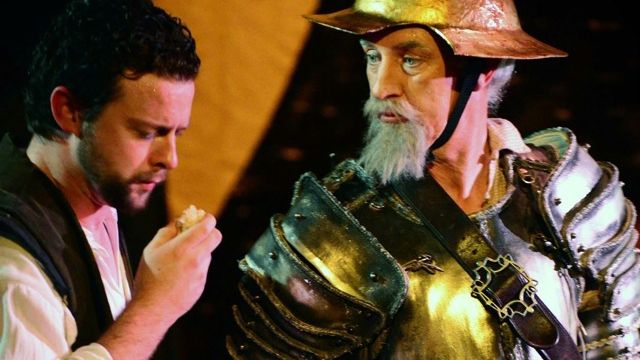Don Quixote
It’s very nice to see Stephen Snars back on stage in a major role. With wispy hair, spikey beard and moustache, heavy armour and compulsory helmet we expect of Don Quixote, he certainly looks the part physically. But it is his soulful, searching blue eyes and wistful expressions that really make him a convincing Knight of the Doleful Countenance.
Snars is on stage for much of this long play, tilting at all the various ‘windmills’ in his path with sustained energy and strong belief that transferred to the audience, even in this preview performance, where teething problems with various cues could easily have affected his constancy. But, with his solicitous, greedy, apple-munching squire Sancho Panza (played enthusiastically by Ben Freeman), he carries the production with the aplomb of a nineteenth century actor-manager.
Mounting a play such as this is brave. There are many ‘chapters’ in the Knight Errant’s story, and many characters he meets along the way. In fact there are 42 other characters in this adaptation of Cervantes’ novel. Some of the eleven supporting cast play six or seven different characters – and this requires direction, acting and characterisation experience not always available in community theatre.
 Such is the case here. Though the supporting cast members work very hard and are obviously enjoying the rough and tumble of the comedic flavour of the writing, many are pushed far beyond their experience and expertise to try to meet the too lofty expectations of the director.
Such is the case here. Though the supporting cast members work very hard and are obviously enjoying the rough and tumble of the comedic flavour of the writing, many are pushed far beyond their experience and expertise to try to meet the too lofty expectations of the director.
More comfortable in their changing roles are Augustin Lamas as Carrasco and the Devil, and Ben Wilson-Hill who finds some nasty dignity in the role of Father Perez. Reich Webber-Montenegro is imposing as the Housekeeper and delivers her asides with studied timing. Therese Bean moves from wench to duchess successfully and Margaret Olive makes an engaging Lady and lisping Dulcinea.
The costumes in this production are many and impressive, some of them coming from Opera Australia. Simply controlling the many costume changes and ‘traffic’ backstage must be a nightmare for the stage manager, but there is also a plethora of staging ‘tricks’ and sound and lighting cues that make the crew work particularly hard.
Some of the staging ideas are clever. Methods of transport dominate these. After all, the knight meets many people along many roads. Quixote’s horse and Sancho’s donkey are real audience pleasers (to say any more would give the impact away) and other wayfarers arrive on stage in a variety of makeshift conveyances.
The landscape and time of the journey is depicted with shadow puppets; the windmill is very effective as are some other lighting ideas; but perhaps a little too much time has been spent on ‘effects’ at the expense of the continuity and pace and timing, which audiences have come to expect of this theatre company. The lighting design is also very clever, overall, but possibly too ‘subtle’ to cope with actors who begin, or end up, out-of-light on too many occasions.
These matters will inevitably improve or pick up as the run proceeds – and audiences will warm to the chivalrous, idealistic Knight Errant – “a fool whose sole intention was doing what is right”.
Carol Wimmer

Subscribe to our E-Newsletter, buy our latest print edition or find a Performing Arts book at Book Nook.

